Shaving the Corneal Flap
Warning: this post isn't for the squeamish. It contains talk and images of eye surgery. On Tuesday, I had the honor of taking my good buddy, Seth St. Martin, to Dr. Mandel of Horizon Vision Center in San Leandro for Wavefront Lasik Surgery. The boy had some of the poorest vision I know of all my friends. His mother would had fears about him getting hurt because if anything happened to his glasses he would be useless. But with a stroke of luck and some very generous parents, Seth was able to alleviate his mother's fear for now he is seeing better than ever.
On Tuesday, I had the honor of taking my good buddy, Seth St. Martin, to Dr. Mandel of Horizon Vision Center in San Leandro for Wavefront Lasik Surgery. The boy had some of the poorest vision I know of all my friends. His mother would had fears about him getting hurt because if anything happened to his glasses he would be useless. But with a stroke of luck and some very generous parents, Seth was able to alleviate his mother's fear for now he is seeing better than ever.
The whole procedure took all of 15 minutes, but the preparations and the waiting dragged on for almost 3 hours. The timing all worked out though as Seth and I used the ample time to chat and catch up. In three hours, there was paperwork to sign, eye drops to be administered, and Valium to kick in as Seth was such a worry wort. One of the coolest parts of the preparations was when Seth asked if I wanted to watch the operation. I happily volunteered. By the time Seth was up, we watched a packed waiting room empty out, and at $4000 a person, we quickly realized how well this profession is doing. Eventually, Seth was called to the OR where he laid down with a worry stone in one hand and a teddy bear clinched in the other. The nurses, the surgeon, and hunking, beige laser machine were hovering all around his head. After he settled in, a nurse came and delivered his glasses to me and brought me in back. It was quite inspiring to know I was the last person to hang onto them while they were still useful. 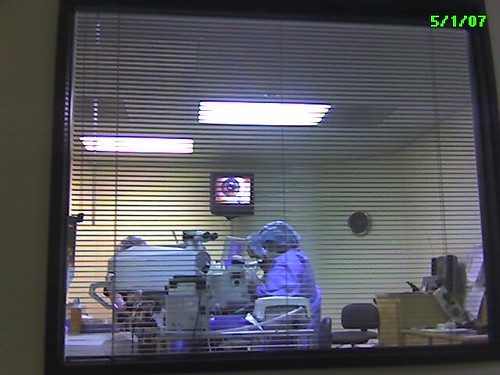
The nurse had led me to the "gallery section" which basically consisted of waiting room chairs along the hallway that faced a large, mini-blinded window of the operation room. I opted to stand right up to the window, though, to get the best view possible, but most of the time, I ended up watching the monitor that focused on Seth's cornea the whole time. 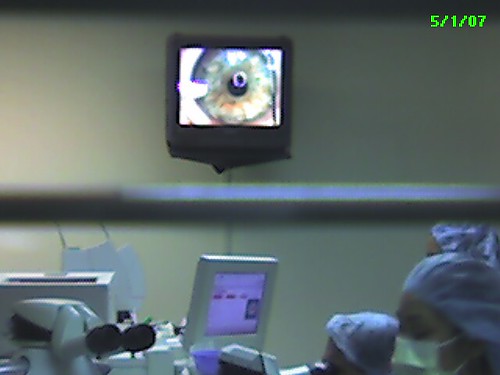
The procedure happens on one eye at a time; for Seth, it was his right then his left. They begin by numbing the eye with a topical anesthetic and inserting a speculum to keep is eye open. Next, the surgeon marks the edges of Seth's cornea with a circular stamp giving the surgeon a reference to realign the cornea at the end of the procedure. 
Then a metal ring is placed over the cornea that is the exact size of Seth's iris. At that point, a electric device is attached to the ring and shaves a thin flap off the top of the cornea. The nurse clears the device, and the surgeon then carefully flips open the corneal flap to expose a lower portion of the cornea where the laser removes a microscopic layer that corrects his refractive error. 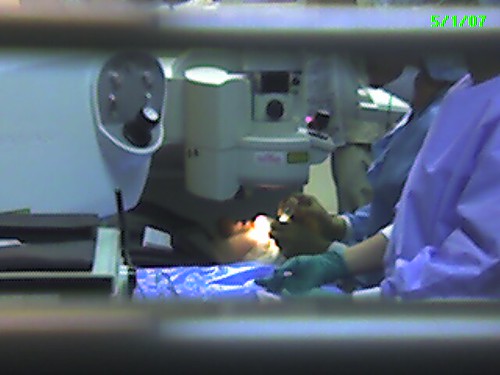
All that is left is to rinse with antibiotics, carefully fold the flap back in place, and realign it so the circles match up.
As soon as it was over and the surgeon gave the thumbs up, Seth was led to an optometrist's chair to have his flaps examined up close. Despite instructions to keep is eyes closed, he had already noticed he could make out faces and read signs better than before. We were both blown away how quickly the results were. Unfortunately, during the initial trial of his new eyes, he somehow managed to ruin the alignment of this right corneal flap. So, the surgeon had to come in and brush the flap back into place. 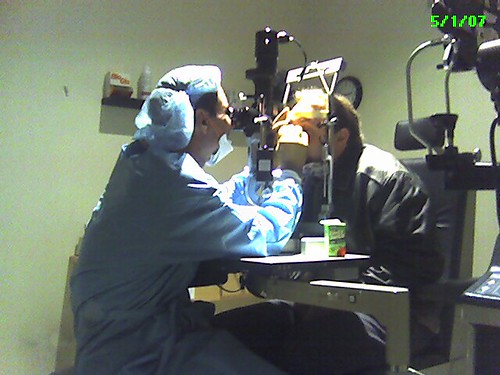
It was nerve racking as hell for my good buddy, but the whole procedure was remarkably quick and painless. Seth spent the evening with this friends and loved-ones supposed keeping his eyes closed as instructed. His girlfriend (Susan), Jeff, and I were charged with being the eye police to keep his eyes closed. Seth spent the following day with Susan shopping for expensive sunglasses.
Culinary Word of the Day: Portobello Mushroom
In honor of my vegetarian friend, I've chosen something I have enjoyed grilling for him in the past. A portobello mushroom is an extremely large, dark brown mushroom that is simply the fully mature form of the crimino, which in turn is a variation of the common cultivated white mushroom. The name "portobello" began to be used in the 1980s as a brilliant marketing ploy to popularize an unglamorous mushroom that, more often than not, had to be disposed of because growers couldn't sell them. The portobello mushroom, which can easily measure 6 inches in diameter, has an open, flat cap. Because it's the elder of the species, the portobello's gills are fully exposed, which means that some of the mushroom's moisture has evaporated. The reduced moisture concentrates and enriches the flavor and creates a dense, meaty texture. Portobellos can be found in gourmet produce markets as well as many supermarkets. Their stems are very woody and should be removed (but saved for soups, stocks, etc.). The caps can be used chopped, as with most mushrooms, but the portobello is much more dramatic used whole. Source: Food Lover's Companion
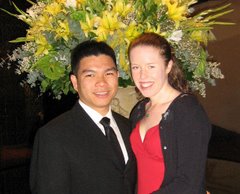






1 comment:
I'm so jealous! Now I want to be able to read signs better and see people's faces without eyeglasses or contacts. You have convinced me! I will look into the procedure. I hear consultations are free anyhow. Great sales pitch Rich!
Post a Comment